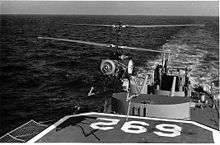Gyrodyne RON Rotorcycle
| Gyrodyne Company of America XRON-I Rotorcycle | |
|---|---|
 | |
| Rotorcycle on display at the Cradle of Aviation Museum | |
| Role | Helicopter |
| National origin | United States of America |
| Manufacturer | Gyrodyne Company of America |
| First flight | 23 November 1955 |
| Primary user | United States Navy |
| Number built | 10 |
| Developed from | Bendix Model 2C |
| Developed into | Gyrodyne QH-50 DASH |
The XRON-I Rotorcycle or YRON-I Rotorcycle (originally designated HOG) was a tiny, single-seat helicopter designed under contract for the U.S. Navy.[1] in the mid-1950s. It later was designed for a United States Marine Corps requirement for a small personal helicopter that would fulfill a number of roles, including observation, liaison, small unit tactical maneuvers, and which could be dropped to downed airmen behind enemy lines to facilitate their escape.[2]
Development
Gyrodyne purchased the assets of Bendix Helicopters in 1949, including the Model 2C coaxial helicopter which provided the technology for the XRON-I. In 1951 the Model 2C was demonstrated to the Navy with shortcomings noted in autorotation control. The XRON-I was demonstrated under a new Navy contract NOas 55-388-c for a lightweight single man helicopter.
Design
Gyrodyne's design was an open-framework helicopter with coaxial rotors, which was evaluated with three different power plants (two reciprocating, one turbine).
The XRON-I uses a manually started 40 hp two-cycle engine with a gross weight capability of 500 lb. The fuselage is a simple box-beam construction. The rotor uses co-axial blades which alleviate the need for an anti-torque tail rotor. Yaw control is provided by rotor tip mounted "tip brakes" providing differential torque between the rotors. Gyrodyne patented the control on 24 October 1954 Patent No. 2,835,331.[3] There is a small inverted V-tail for control at forward speeds. The rotors are laminated wood construction. The mast is pressure lubricated and becomes a cooling surface for oil inflight. The landing gear consists of three small wheels.[4]
Operational history
The first flight was on November 1955. The two-cycle engine was prone to overheating and other engines were added to the program for testing. The Marine Corps also tested one XRON-I, and three YRON-1 prototypes.[5]
The Marine Corps eventually concluded that both the RON, and the competing Hiller ROE were too heavy and too difficult to fly and abandoned the project. The United States Navy, however, had noticed the compact size and high load-carrying capacity of the RON, and in 1960 awarded a contract to Gyrodyne to produce a radio-controlled drone version of the Rotorcycle, to be used as an Anti-Submarine Warfare (ASW) platform. Using the dynamic components of the RON, this was eventually developed as the Gyrodyne QH-50.
The Rotorcycle went on to win the prize for most maneuverable helicopter at the Paris Air Show in 1961, and was selected for a 1964 trade fair in Morocco by the United States Department of Commerce.
A 2 place enclosed "gyrocycle" commercial variant was proposed after initial tests.[6]
Variants

- 55 HP 4-Cycle Porsche YO-95-2 model Model GP-702/1 600cc variant with 17 ft rotors.
- 55 HP Solar YT62 turbine model with 17 ft rotors.
- 72 HP 4-Cycle Porsche YO-95-6 engine variant - Rotor increased to 20 ft, 5 units built and tested at Pax River and Camp Pendleton.
- 62 hp Solar T62 gas turbine engine and 15 ft rotor.[7]
- The DSN-1 modified as a drone.
On display
The Cradle of Aviation Museum in New York has a XRON-I on display [8]
On display at The New England Air Museum, Windsor Locks, CT.[9]
Specifications
Data from Jane's All The World's Aircraft 1961–62[1]
General characteristics
- Crew: 1
- Length: 11 ft 6 in (3.51 m)
- Empty weight: 550 lb (249 kg)
- Gross weight: 832 lb (377 kg)
- Max takeoff weight: 906 lb (411 kg)
- Powerplant: 1 × Porsche YO-95-6 4-cylinder air-cooled horizontally opposed piston engine, 72 hp (54 kW)
- Main rotor diameter: 2× 20 ft (6.1 m)
- Main rotor area: 314 sq ft (29.2 m2)
Performance
- Maximum speed: 78 mph (126 km/h; 68 kn)
- Cruise speed: 60 mph (52 kn; 97 km/h)
- Range: 55 mi (48 nmi; 89 km)
- Ferry range: 112 mi (97 nmi; 180 km) (overload weight, auxiliary fuel)
- Service ceiling: 12,400 ft (3,780 m)
- Rate of climb: 1,140 ft/min (5.8 m/s)
See also
References
| Wikimedia Commons has media related to Gyrodyne RON Rotorcycle. |
- Citations
- 1 2 Taylor 1961, p. 261.
- ↑ Popular Mechanics. July 1956. Missing or empty
|title=(help) - ↑ "XRON history". Retrieved 7 June 2011.
- ↑ Sport Aviation. November 2011. Missing or empty
|title=(help) - ↑ Norman Polmar. Historic naval aircraft: from the pages of Naval history magazine.
- ↑ Sport Aviation. December 1958. Missing or empty
|title=(help) - ↑ FLIGHT, 27 May 1960 p727
- ↑ "SVSM Gallery". Retrieved 7 June 2011.
- ↑ http://www.neam.org/index.php?option=com_content&view=article&id=135
- Bibliography
- Taylor, John W. R. (1961). Jane's All The World's Aircraft 1961–62. London: Sampson Low, Marston & Company, Ltd.
- Taylor, Michael J. H. (1989). Jane's Encyclopedia of Aviation. London: Studio Editions. p. 455.
- Simpson, R. W. (1998). Airlife's Helicopters and Rotorcraft. Ramsbury: Airlife Publishing. p. 220.
- Rawlins, Eugene W. (1976). Marines and Helicopters 1946-1962. Washington DC: History and Museums Division Headquarters, United States Marine Corps. p. 89.
- The Rotorcycle. Gyrodyne Company of America.